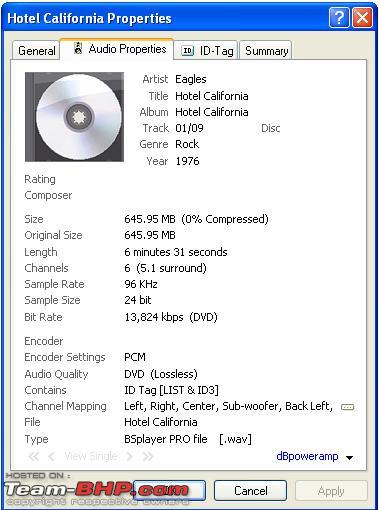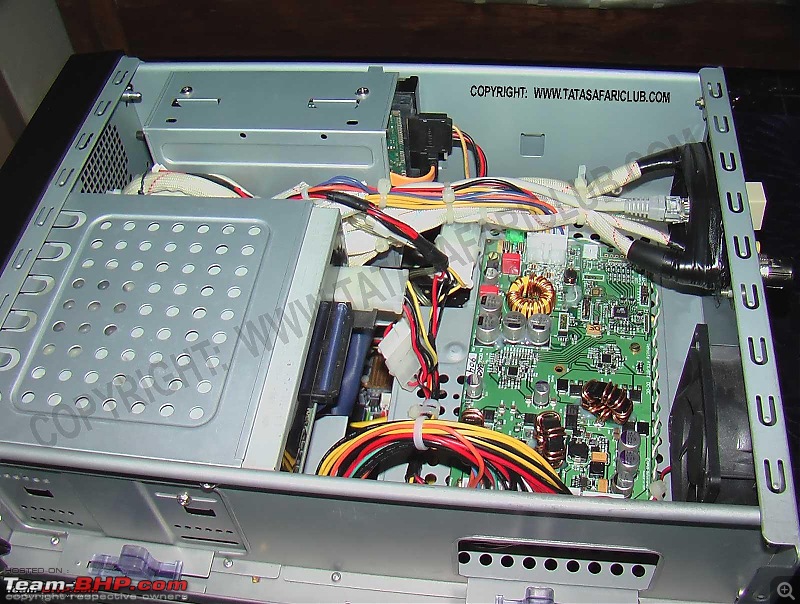Quote:
Originally Posted by ibm_jennifer  Leave about ARC. Do you know whats RTA and what it does? have you ever tried Alphine 605 - Do you know where from they get their algorithm?
I agree with you and I am not using with any EQ or DSP for SQL.
Its True. But can you show me a Car speaker which reproduce the frequencies perfectly in a car environment?
Noise and rattling issue are trademarks of TATA and you need some brain and time to solve it yourself. if you don't have any of that, I advise you stay away from a Safari.
And in my world, a software is not a true RTA, if it wont support 1/24th octave resolution FR and 1/24th octave Phase Response with Magnitude & Coherenc and inbuilt professional mic and sound card calibration. |
Quote:
Originally Posted by ibm_jennifer  There is no big difference bw this High End and my poor JBL 607 if I am playing Lossless 24 bit 192KHz samples.
The secret is where the Distortion happens, it happens at your source, for me its at the destination.
But its impossible now because there is no High End Speakers available to reproduce the input with a Flat FR Curve.
There is no Cross-over available here without introducing Group Delay,
There is no Amplification/EQ available here with out Phase delay. |
Quote:
Originally Posted by ibm_jennifer  There are no more advantages in DTS-MA/TrueHD/24-192 Flac when comparing to DVD/CD other than High Dynamic range, Less Quantization Errors, Pure Transients, Lower Noise Floor, More Headroom, Less Jitter, Zero DC Offset, less Aliasing effects and finally more frequency spectrum.
If you cant feel any difference, You are really very OLD or you need to train your ears. |
Quote:
Originally Posted by ibm_jennifer  There is no use of explaining this mastering techniques to an end user unless your ear cant find any difference. The main Aim of this 24/192 is to simulate the old day Analog Harmonics in the Digital Music with pure reproduction.. |
Quote:
Originally Posted by DerAlte  * High Dynamic range: cannot exceed that of the recorded stream
Using an Dynamic Range expander (in the 80s DBX made analog versions - I used the 3BX-DS)
* Less Quantization Errors: but no one will be able to figure out LSB errors in playback, right?
On a 44/16 signal the errors in lower 2 bits are very diffcult to tell - 3rd LSB on it is audible. On a 192/24 bit signal LSB error should be more tolerant.
* Less Jitter: OK, what is the practical impact?
easily resolves using a buffer.
Hello boss, please do not assume that others have an inability to discriminate.
These concepts have been around since ages..What you are seeing today as path breaking discoveries are actually another step in the process of evolution of signal reproduction techniques. |
DA,
I have put my comments to your post in bold.
IBM_J.
1. Please do NOT underestimate the knowledge of many on this forum. I do not consider myself a guru - there are many here whose depth of knowledge far exceeeds mine - but even I would not like to be underestimated. And BTW I am OLD, old enough to have first used RTAs in 1976-7 even if it was only a simple 1/3 octave 33 band RTA.
2. I have used an Alpine 650. In understand it's limitaitons. I might not use it again unless the application demanded the use of such a product. My wife's car has a 650.
3. You say you are not using any EQ or DWSP for SQL but on antoehr thread did you recommend the same to B&T? If so why? Forgive me if I am mistaken.
4. There is no perfect speaker (car or home) not even a speaker that has a flat frequency response (car or home), power response (car or home). All SUBJECTIVE listening sessions (not tests) have indicated that such a speaker is not nesscarily desireable.
5. You mention an RTA with "1/24th octave resolution FR and 1/24th octave Phase Response...". Really why do you need 1/24th octave RTA? That would mean 240+ bands of display! Do you view music or listen to it?
6. ofcourse no XO has 0 group delay - as long as the group delay is constant it is fine as the transiest response will be good. However even better people that you or me have had no problem with speakers even if the XO has a NON-constant group delay. Sigfried Linkwitz for example.
BTW it is mathematically possible to simulate a XO that has 0 group delay. all one needs to do is add an all-pass network to the XO that has the inverse group delay of the XO in question however in practice this would mean that you'd need the negative group delay meaning that the correction All pass network responds before it receives its triggering signal, which is obviously not possible!
The way to create a 0 group delay would be to saple the signal and use DSP to "reverse" the signal in the time domain (say using LIFO buffers) etc.. I dot know if such a system is practically implementable but the theory allows for it to be.
7. Similar DSP techniques can be used to sole phase delay.
we can go one but you get the picture.
Quote:
Originally Posted by frankmehta  on a more serious note? Why not a playstation 3? |

you funny man! Watching video in a car while driving can be dangerous; you want IBM_J to play GT5!












 you funny man! Watching video in a car while driving can be dangerous; you want IBM_J to play GT5!
you funny man! Watching video in a car while driving can be dangerous; you want IBM_J to play GT5! 

